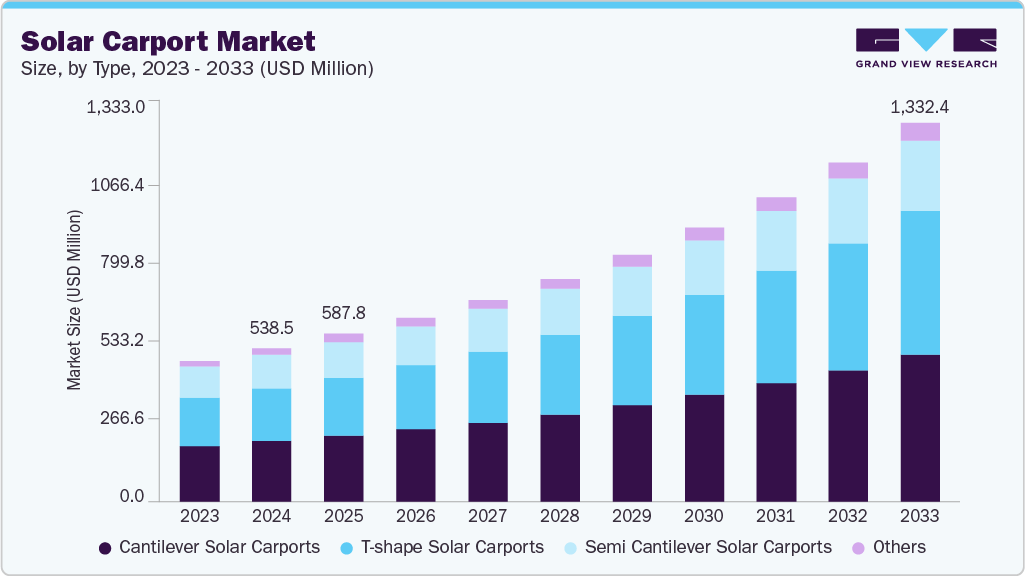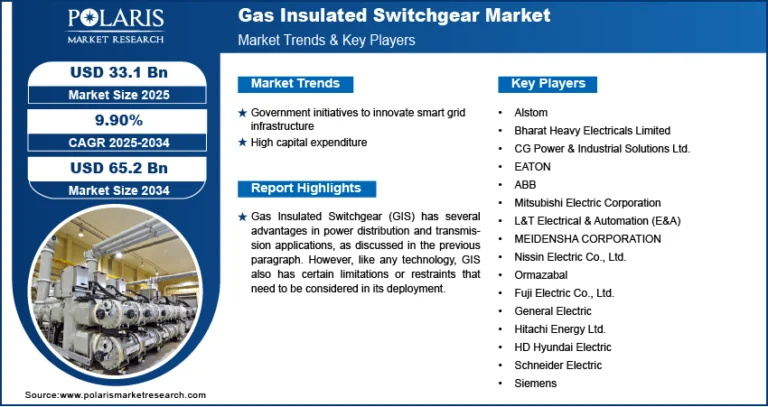Solar Carport Market Size, Share & Trends Analysis growing at a CAGR of 10.8% from 2025 to 2033

The global solar carport market size was estimated at USD 538.5 million in 2024, and is projected to reach USD 1,332.4 million by 2033, growing at a CAGR of 10.8% from 2025 to 2033. The increasing demand for sustainable and renewable energy sources, along with the rising necessity for eco-friendly transportation, is propelling the growth of the solar carport industry.
Key Market Trends & Insights
- North America dominated the solar carport industry and is expected to register a notable CAGR of 9.7% from 2025 to 2033.
- The U.S. solar carport market held a dominant position in the region in 2024.
- By type, the T-shape solar carports segment dominated the market in 2024 and accounted for the largest share of 39.3%.
- By vehicle arrangement, the two-row vehicle arrangement carports segment held the largest market in 2024.
- By capacity, the above 1MW segment dominated the market in 2024 and is expected to grow at the fastest CAGR during the forecast period.
Market Size & Forecast
- 2024 Market Size: USD 538.5 Million
- 2033 Projected Market Size: USD 1,332.4 Million
- CAGR (2025-2033): 10.8%
- North America: Largest market in 2024
- Asia Pacific: Fastest growing market
Request a free sample copy or view report summary: https://www.grandviewresearch.com/industry-analysis/solar-carport-market-report/request/rs1
Solar carports offer a dual advantage by providing protection and shade for vehicles, simultaneously reducing energy expenses and fostering sustainability through the generation of clean energy. They offer protection against various environmental elements, such as snow, hail, rain, and direct sunlight, which can potentially damage vehicles over time. Additionally, they contribute to maintaining cooler temperatures for cars during hot weather by providing shade. Solar carports come in a variety of sizes and designs, making them adaptable and versatile to fit different spaces and preferences. Thus, the increasing adoption of solar carports in various commercial and residential applications owing to its benefits is fueling the market’s growth.
The increasing adoption of electric vehicles (EVs) and reduced dependence on fossil fuels are driving the demand for solar carports. Solar carports can also integrate charging infrastructure for EVs. This involves the installation of electric vehicle supply equipment (EVSE) that enables drivers to recharge their EVs utilizing the solar energy produced by the carport. With an increasing number of people adopting EVs, the need for reliable and cost-effective EV charging solutions is on the rise, encouraging businesses to explore innovative ways of accommodation. Therefore, renewable energy solutions such as solar carports are gaining popularity as a viable option for powering EVs.
Increasing adoption of solar carports by various universities and other educational institutes to become carbon neutral in the upcoming years is driving the market’s growth. In April 2025, as part of its Earth Week celebrations, Fullerton College announced the completion of a new solar carport system, developed in collaboration with ForeFront Power, a prominent developer and asset manager of commercial and industrial-scale solar and energy storage projects.
The 1 megawatt-DC solar parking canopy, situated in Student Parking Lot 5 near Sherbeck Field, is expected to generate nearly USD 6 million in energy cost savings for the college over the next two decades.Fullerton College undertook this project to lower utility expenses, decrease its carbon footprint, and support its sustainability objective of shifting campus energy use to 100% renewable sources. Such initiatives are expected to improve the growth of the solar carport industry during the forecast period.
Despite various benefits and promising prospects related to solar carports, it has specific challenges and limitations that could hamper the growth of the market. Solar carports may incur substantial costs and necessitate a significant initial investment. Also, depending on the complexity and size of the system, the installation time of the carports can vary significantly. In some cases, it can take several months or weeks before a solar carport is completely operational. In addition, solar panel systems used in solar carports require regular maintenance to function properly and generate optimal energy over time. However, the growing investment in building solar carports by several commercial and residential building owners is expected to improve the market’s growth.






